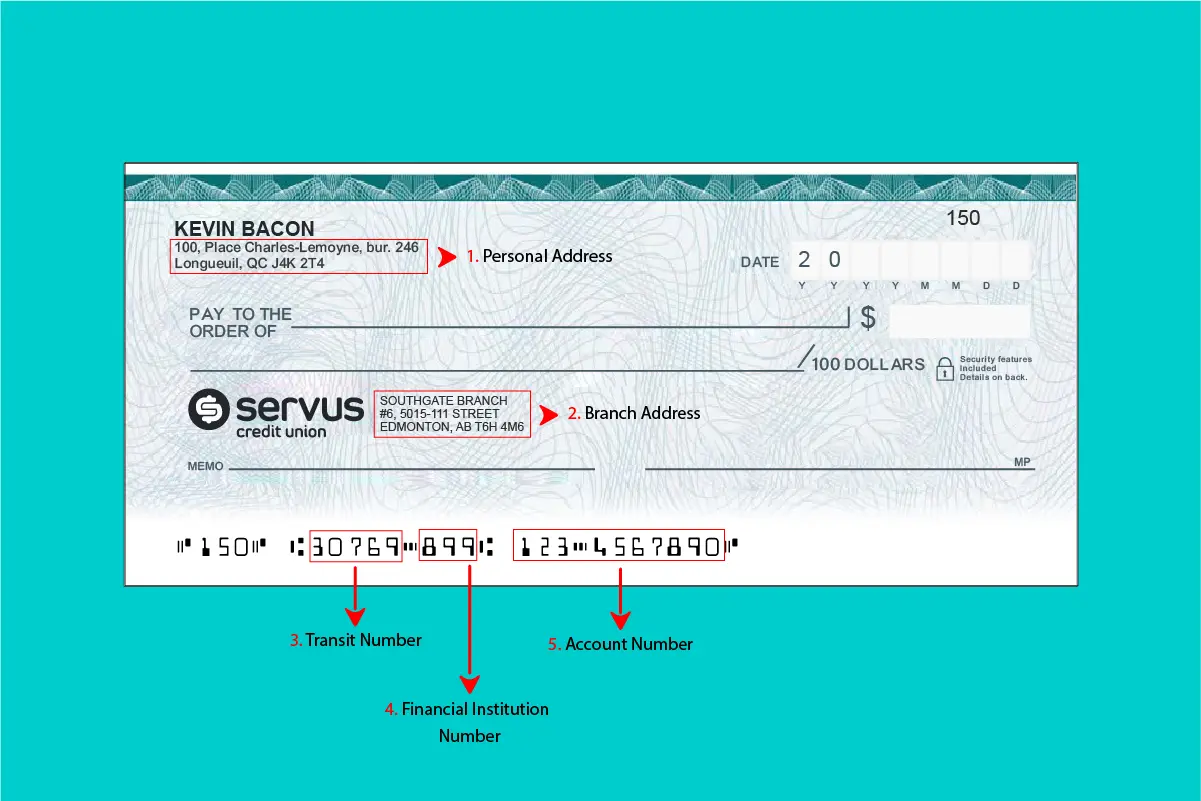Servus Credit Union Void cheque: Everything you need to know to find and understand it
By Arthur Dubois | Published on 02 Mar 2022

From pre-authorizing payments to getting paid, sample cheques still come in handy even though cheques are rarely used in Canada. The main reason you need a Servus Credit Union sample cheque is to share your banking information with someone else.
Understanding Your Servus Credit Union Void Cheque
If you know what the numbers at the bottom of your Servus Credit Union void cheque mean, you can probably just share them without having to go looking for a Sample Cheque in your banking portal every time someone asks for one.
So, here are the important features of a cheque in Canada that you should be able to recognize by looking at one :
1. Your home address
This is the information you don’t need to look at a void cheque to know. However, it is often needed by those who ask you for a void cheque.
2. Your branch address
This is the address of your Servus Credit Union branch. Note that some Servus Credit Union branches have more than one point of service.
3. Your branch transit number
This is a 5-digit number that identifies the Servus Credit Union branch to which your bank account is associated.
4. Your bank Institution Number
The institution number is a three-digit number that identifies the financial institution you are dealing with, regardless of the branch you have chosen. Servus Credit Union’s institution number is 899.
5. Your account number (or folio number)
The account (or folio) number is the identifier for your bank account. Without the transit number and institution number, it cannot be used to transfer money. As a result, it is the most sensitive information you will find on your sample cheque, as it is the number that is associated with your bank account. This number varies in length depending on the financial institution but generally ranges from 7 to 12 digits.
How to find your void cheque on the Servus Credit Union online portal
Before the Internet, a sample cheque was a paper cheque with “SAMPLE” or “VOID” written on it to ensure that the cheque could not be used. If you have a chequebook, you can still do this. In fact, a sample cheque is a document that contains all the information displayed on a cheque, so you can still do it that way.
For those who don’t want to waste paper, or who simply don’t have a chequebook, it is possible to obtain a Servus Credit Union sample cheque by logging into the Servus Credit Union online portal. Here are the steps to download a Servus Credit Union sample cheque in PDF format with just a few clicks:
For Pre-Authorized Debits
- Log into your Servus Credit Union account through using the following link: https://www.servus.ca/life
- Select the account you want the funds to come out of
- Click on “Account Quick Links” then “Void Cheque Authorization”
- A PDF will be created for you
- Select “Download” or “Print”
For Direct Deposits
- Log into your Servus Credit Union account through using the following link:
https://www.servus.ca/life - Select the account you want the funds to be deposited to
- Click on “Account Quick Links” then “Direct Deposit Authorization”
- A PDF will be created for you
- Select “Download” or “Print”
Now you know everything you need to know about finding your Servus Credit Union sample cheque, and how to interpret the different elements on it. Furthermore, you should now be able to write a cheque.
